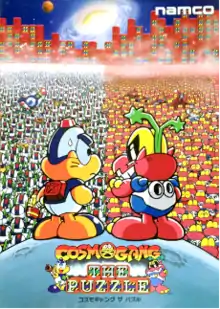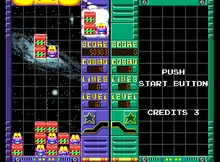Cosmo Gang the Puzzle
Cosmo Gang the Puzzle[lower-alpha 1] is a 1992 falling tile puzzle arcade game developed and published in Japan by Namco. It is the third game in the Cosmo Gang series, succeeding Cosmo Gang the Video. Players stack blocks and pink-colored aliens together, the objective being to clear as many of these as possible. Blocks are cleared by stacking them into rows of six, while aliens are cleared by dropping blue-colored spheres, which defeat any enemies in its path.
| Cosmo Gang the Puzzle | |
|---|---|
 Promotional flyer | |
| Developer(s) | Namco |
| Publisher(s) | Namco |
| Series | Cosmo Gang |
| Platform(s) | Arcade, Super Famicom, Mobile phone |
| Release |
|
| Genre(s) | Puzzle |
| Mode(s) | Single-player, multiplayer |
Namco ported the game to the Super Famicom a year later in 1993. This version of the game was reworked and reskinned as Pac-Attack for North America and Europe, which was later ported to other consoles such as the Sega Genesis and Game Boy. Cosmo Gang the Puzzle was met with a mixed reception from critics, being praised for its multiplayer aspect and gameplay but criticized for its graphics. The Super Famicom version was released on the Wii Virtual Console in 2008 and Wii U Virtual Console in 2015, while the arcade version was released for the Wii Virtual Console in 2009 — all of these ports were exclusive to Japan.
Gameplay

Cosmo Gang the Puzzle is a falling-tile puzzle game. Using the joystick, the player must stack groups of blocks and pink-colored aliens, known as "Jammers", onto the game board, the objective being to clear as many possible before they stack to the top of the screen.[1] Blocks can be cleared by matching them into horizontal rows of six, while Jammers can be defeated by blue-colored balls, which will point in the direction they will move and clear any Jammers in its path. A meter located at the middle of the screen will fill up each time a Jammer is cleared - once this meter is filled, a star will drop from the top of the screen and clear all Jammers on-screen. The game becomes progressively more difficult as it progresses, increasing the speed of the dropping blocks and Jammers. Once the blocks and Jammers reach the top of the screen, the game will be over.[2]
Alongside a single-player option, a multiplayer option is also available. The second player's screen will replace the Jammers with white-colored robots named 'Pipopapo-Tai", which behave the same as regular Jammers. In the multiplayer mode, the objective is to fill up the other player's screen, which can be accomplished by clearing more Jammers than the other player, causing the other's enemies to fall onto the opponent's side. The game will end once a player's blocks and Jammers reach the top.
Reception
| Publication | Score |
|---|---|
| Famitsu | 29/40[3] |
| GamesMaster | 55%[4] |
| Sinclair User | 76/100[5] |
| Super Play | 58%[6] |
| Super Famicom Magazine | 21.63/30[7] |
| Publication | Award |
|---|---|
| Gamest | 7th Gamest Award, 16 Annual Hit Game[8] |
Cosmo Gang the Puzzle was only a moderate success in arcades.[8] It was awarded the 16th Annual Hit Game award from Gamest based on reader vote.[8] A writer for Sinclair User enjoyed the game for its addictive quality and mechanics. They wrote that while it wasn't an original concept by any means, Cosmo Gang the Puzzle was still an enjoyable game in its own right, and made for a solid take on the Tetris formula.[5]
Reviewers weren't as enthusiastic about the Super Famicom version. One common complaint was that the gameplay wasn't as gratifying or well-designed as other puzzle games already on the market.[3][4][6] The four reviewers of Famitsu felt that it lacked the same level of refinement as Puyo Puyo or the simplicity of Tetris.[3] Andy Lowe from GamesMaster stated that while he felt Cosmo Gang the Puzzle possessed more "involved" gameplay than Tetris, it lacked substance and didn't have as many features that other similar games had.[4] Super Play's Matt Bielby disliked the difficulty for being too easy and the gameplay for becoming tedious after a while, writing that its quirkiness couldn't save it from becoming "cupboard-fodder".[6] Andy and Bielby both found the price too expensive for a game that offered little in the way of content.[4][6]
Critics showed appreciation towards Cosmo Gang the Puzzle for its novelty and some of its concepts.[3][4][6] Lowe said that the game had a wider scope than other Tetris clone games did, and that it "features some devilishly strategic touches" that other titles lacked.[4] Biebly agreed and said that what little depth that Cosmo Gang had was very innovative, finding some of Namco's additions to be creative.[6] Writers for both Famitsu and Super Famicom Magazine liked the multiple gamemodes for offering a different take on the falling tile gameplay.[3][7] Famitsu staff in particular were fond of the Vs. Mode for its more relaxing pace, writing that it was a necessity for games of its kind.[3] Lowe and Bielby both enjoyed the puzzle mode for its layer of strategy and depth;[4][6] Lowe in particular believed that it was the best aspect of the game.[4] The game's graphics, character animations, and soundtrack also received praise.[4][6] Super Famicom Magazine concluded their review by writing that Puzzle made for a nice addition to the console's library, and outclassed the arcade original with its new features.[7]
References
- "Cosmo Gang The Puzzle - Videogame by Namco". Killer List of Video Games. Retrieved 1 July 2019.
- "Coin-Ops - Cosmo Gang the Puzzle" (March). Sinclair User. Retrieved 1 March 1993. pg 29.
- "コズモギャング ザ パズル (SFC)". Famitsu (in Japanese). Kadokawa Corporation. Archived from the original on October 31, 2015. Retrieved October 4, 2020.
- Lowe, Andy (March 1993). "Reviews - Cosmo Gang the Puzzle" (5). Future Publishing. GamesMaster UK. p. 82. Retrieved October 4, 2020.
- "Coin Ops - Cosmo Gang the Puzzle" (March 1993). EMAP. Sinclair User. p. 29.
- Bielby, Matt (May 1993). "Import Review - Cosmo Gang the Puzzle" (7). Future Publishing. Super Play. p. 67. Retrieved October 4, 2020.
- "8月情報号特別付録 スーパーファミコンオールカタログ'93" [August Information Issue Special Appendix Super Nintendo All Catalog '93] (in Japanese). Tokuma Shoten. Super Famicom Magazine. August 1, 1993. p. 91.
- GAMEST MOOK Vol.112 ザ・ベストゲーム2 アーケードビデオゲーム26年の歴史 [GAMEST MOOK Vol. 112 - The Best Game 2: 26 Years of Arcade Video Games History] (in Japanese) (Volume 5, Number 4 ed.). Gamest. January 17, 1998. pp. 12–13. ISBN 9784881994290.